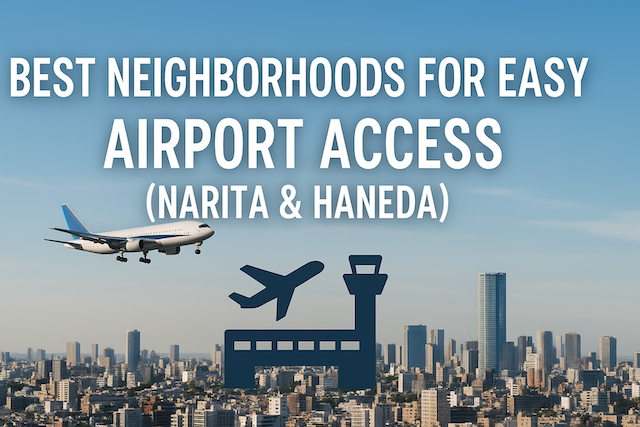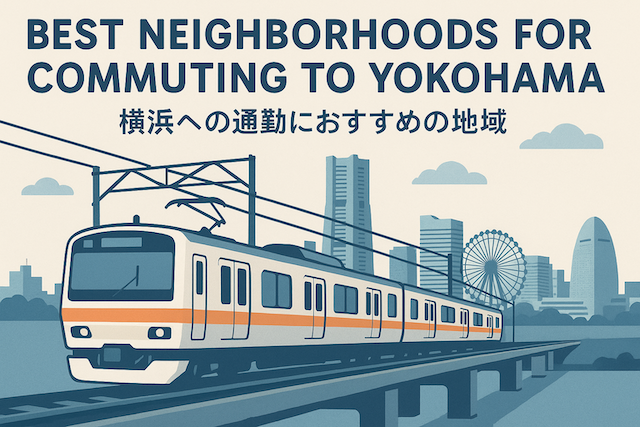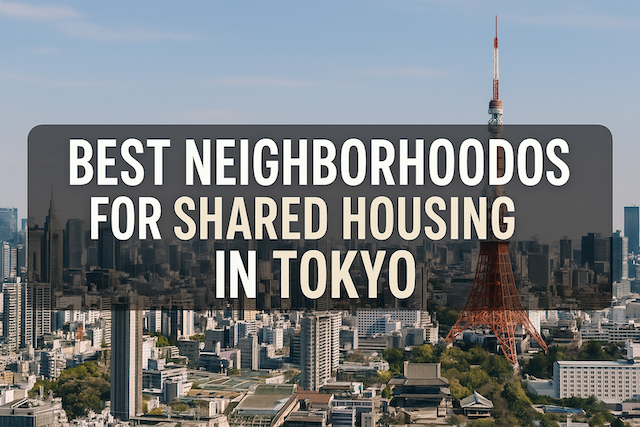Best Neighborhoods for Easy Airport Access (Narita & Haneda)
When choosing a place to live in Tokyo, one key factor for many residents and frequent travelers is how easily they can get to the airports — Narita International Airport and Haneda Airport. Whether you’re a business traveler who flies often, an expat who visits home regularly, or simply someone who wants to minimize stress before a flight, living in an area with convenient airport access can make a huge difference.
Tokyo offers a wide range of neighborhoods that balance convenience, comfort, and lifestyle, while keeping you well-connected to both airports. Below, we’ll explore the best areas that make airport access quick and hassle-free — by train, bus, or car.
Shinagawa: The Ultimate Transport Hub
Shinagawa is one of the most strategic places to live for anyone who values quick airport access. The station connects directly to Haneda Airport via the Keikyu Line, with travel times as short as 15 minutes. For Narita Airport, you can hop on the Narita Express (N’EX), which takes around 65–70 minutes.
Aside from its transportation advantages, Shinagawa is a lively business and residential district with modern high-rises, luxury hotels, and excellent dining options. The area is also home to large corporate offices and foreign company headquarters, making it a favorite among expats and business professionals.
Key advantages:
-
Direct access to both airports
-
Wide selection of serviced apartments and modern condos
-
Great mix of work-life balance and amenities
-
Walking distance to waterfront parks and cultural spots
Hamamatsuchō: Closest to Haneda Airport
If your flights often depart from Haneda, Hamamatsuchō is almost unbeatable in terms of convenience. The Tokyo Monorail connects Hamamatsuchō Station directly to Haneda Airport in about 20 minutes, making it one of the fastest routes available.
The area also benefits from proximity to the Yamanote Line, which means you can easily reach central business districts like Shimbashi, Tokyo Station, and Shinjuku. Hamamatsuchō has a mix of modern office towers, hotels, and high-rise apartments — perfect for professionals who value efficiency.
Key advantages:
-
Fastest access to Haneda via Tokyo Monorail
-
Great for frequent flyers and business travelers
-
Excellent Yamanote Line connectivity
-
Easy commute to central Tokyo
Ueno: Convenient for Narita Airport Travelers
If your international flights are mainly from Narita, Ueno is one of the most practical places to live. The Keisei Skyliner runs directly from Ueno Station to Narita Airport in about 40 minutes, one of the fastest train connections available.
Ueno also offers an authentic Tokyo atmosphere, with bustling shopping streets like Ameyoko, world-class museums, and cultural attractions such as Ueno Park and Tokyo National Museum. Despite its central location, it’s still relatively affordable compared to neighborhoods like Shinjuku or Roppongi.
Key advantages:
-
Fastest train access to Narita Airport
-
Budget-friendly apartments and guesthouses
-
Cultural and historic surroundings
-
Great local shopping and dining options
Tokyo Station Area: Direct Access to Narita Express
Living near Tokyo Station means having direct access to both airports, but especially Narita via the Narita Express (N’EX). The journey takes about 60 minutes, with trains departing frequently throughout the day. For Haneda, the Tokyo Monorail and Keikyu Line are just one transfer away.
Tokyo Station’s surroundings — particularly the Marunouchi and Yaesu districts — offer luxury living, fine dining, and premium shopping. While the rent is on the higher end, the convenience and prestige make it worthwhile for executives and expats.
Key advantages:
-
Direct N’EX access to Narita
-
Proximity to major business hubs
-
Premium condos and serviced residences
-
Seamless train and Shinkansen connections
Ebisu: Comfort Meets Connectivity
Ebisu offers a great balance between comfort, style, and accessibility. From Ebisu Station, you can reach Shinagawa (for Haneda access) in just 7 minutes on the Yamanote Line, and from there, you can take the Keikyu Line to Haneda Airport. Narita is accessible via the Narita Express, which passes through nearby Shibuya and Tokyo stations.
Ebisu is one of Tokyo’s most desirable residential neighborhoods, known for its trendy restaurants, Ebisu Garden Place, and relaxed yet upscale vibe. For residents who prioritize both lifestyle and convenience, Ebisu is a top pick.
Key advantages:
-
Fast transfer to Shinagawa for Haneda access
-
Stylish, upscale living environment
-
Popular with expats and professionals
-
Excellent dining and nightlife options
Shibuya: Central and Well-Connected
Shibuya isn’t directly connected to either airport, but it offers easy transfers to lines that are. You can reach Shinagawa in 11 minutes for Haneda access or Tokyo Station in 17 minutes for Narita Express connections. Additionally, the Airport Limousine Bus service from major Shibuya hotels goes directly to both airports.
Shibuya is a vibrant, youthful area full of energy, entertainment, and new developments like Shibuya Scramble Square. It’s a great choice for young professionals or digital nomads who want to stay in the center of Tokyo without sacrificing airport accessibility.
Key advantages:
-
Multiple airport bus routes
-
Fast train access to Shinagawa and Tokyo Station
-
Modern apartments and co-living spaces
-
Ideal for dynamic, urban lifestyles
Meguro: Quiet Residential Area with Great Links
Meguro is a calm, green neighborhood just 10 minutes from Shinagawa Station by train, giving residents quick access to Haneda via the Keikyu Line. For Narita, transfers through Tokyo or Shibuya make it relatively simple.
Meguro offers a relaxed residential environment while staying close to the city center. The area is known for its leafy streets, stylish cafes, and peaceful river walks — ideal for families or professionals seeking quiet living with practical transportation.
Key advantages:
-
10 minutes to Shinagawa
-
Quick transfer to Haneda
-
Calm, upscale atmosphere
-
Popular among families and long-term residents
Oimachi: Direct Train to Haneda
For those who want a direct, no-transfer route to Haneda Airport, Oimachi is an excellent option. The Keikyu Line and Rinkai Line provide convenient airport connections. You can reach Haneda in about 25 minutes.
Oimachi also offers lower rents compared to central Tokyo, while still being connected to business areas like Shinagawa and Shibuya. It’s a smart choice for budget-conscious residents who travel frequently.
Key advantages:
-
Direct train to Haneda Airport
-
Affordable rent for a well-connected area
-
Convenient to Shinagawa and Shibuya
-
Good mix of local and modern lifestyle
Nippori: Great for Skyliner Access to Narita
Nippori Station is another excellent neighborhood for easy Narita Airport access. The Keisei Skyliner stops here before heading directly to the airport, taking just 36 minutes. It’s perfect for residents who fly internationally often but prefer a quieter neighborhood than Ueno.
The area also offers good access to the Yamanote Line, giving you quick connections to Tokyo’s central districts. Nippori retains a nostalgic “old Tokyo” atmosphere, especially around the Yanaka Ginza shopping street.
Key advantages:
-
Direct Skyliner service to Narita
-
Quiet, traditional atmosphere
-
Easy access to Yamanote Line
-
Affordable rent compared to central Tokyo
Kawasaki: Outside Tokyo but Extremely Convenient
Although technically in Kanagawa Prefecture, Kawasaki is an excellent choice for people who use Haneda Airport frequently. It’s only 15–20 minutes away via Keikyu Line or car. The area offers larger living spaces at more reasonable prices than central Tokyo.
Kawasaki has modern shopping centers, entertainment options, and a growing expat community. It’s especially attractive for families or commuters who want suburban comfort without sacrificing accessibility.
Key advantages:
-
Closest major city to Haneda Airport
-
Affordable housing options
-
Great balance between city and suburb life
-
Direct train access to Tokyo and Yokohama
Conclusion: Choose Based on Your Airport and Lifestyle
If you mainly fly from Haneda Airport, neighborhoods like Shinagawa, Hamamatsuchō, Oimachi, and Kawasaki are unbeatable for convenience.
If your flights are primarily from Narita Airport, Ueno and Nippori offer the fastest and most direct train connections.
For those who want a balance between lifestyle and convenience, areas like Ebisu, Meguro, and Shibuya provide excellent access while offering a vibrant and comfortable living environment.
No matter which airport you frequent, Tokyo’s world-class transportation network ensures that you can always find a neighborhood that fits both your travel habits and your lifestyle preferences.
What are the fastest neighborhoods for Haneda Airport access?
Shinagawa and Hamamatsuchō are typically the quickest. From Shinagawa, you can use the Keikyu Line for a short ride to Haneda. From Hamamatsuchō, the Tokyo Monorail offers frequent, direct services to all Haneda terminals. Both areas sit on the Yamanote Line, so they’re easy to reach from central Tokyo and offer strong late-evening frequency.
Which neighborhoods are best for Narita Airport access?
Ueno and Nippori are top choices because they sit on the Keisei lines used by the Skyliner. The Skyliner delivers one of the fastest and most comfortable rides to Narita. If you prefer JR, living near Tokyo Station provides direct Narita Express (N’EX) access with frequent departures and ample luggage space.
Shinagawa vs. Hamamatsuchō: which should I choose?
Pick Shinagawa if you want a larger residential selection, more dining, and super easy transfers to Shinkansen and the Keikyu Line. Choose Hamamatsuchō if your priority is the Tokyo Monorail to Haneda and quick Yamanote links to business hubs like Shimbashi and Tokyo. Both are excellent; your choice depends on lifestyle and commute patterns.
Ueno vs. Nippori for Narita: what’s the difference?
Both offer fast Skyliner access. Ueno provides a lively environment with museums, parks, and shopping, plus more rental stock and nightlife. Nippori is quieter, slightly more residential, and known for a nostalgic “old Tokyo” vibe near Yanaka. If you want energy and amenities, go Ueno; if you prefer calm and value, consider Nippori.
Is living near Tokyo Station worth it for airport access?
Yes, if you value premium convenience. Tokyo Station gives direct Narita Express service and easy transfers to Haneda via JR/Monorail/Keikyu. The area is upscale (Marunouchi/Yaesu) with higher rents, excellent security, and unmatched connectivity for work trips, day trips on Shinkansen, and early-morning international flights.
What about neighborhoods that balance lifestyle and access?
Ebisu, Meguro, and Shibuya offer vibrant living with quick transfers to Shinagawa (for Haneda) or Tokyo/Shibuya (for N’EX or Skyliner connections). You’ll find modern apartments, abundant dining, and nightlife, while still keeping airport trips under control with simple, well-signed transfers and frequent trains or limousine buses.
Are there more affordable options with good access?
Oimachi is a smart, budget-friendlier base for Haneda due to convenient Keikyu and Rinkai connections. Nippori offers value while keeping Skyliner access. Kawasaki (just outside Tokyo) also provides larger spaces and quick Haneda trips. These areas trade a little centrality for savings without sacrificing airport convenience.
How reliable are late-night or early-morning connections?
Tokyo’s airport lines are reliable, but first and last train times matter. If you often catch red-eyes or dawn departures, prioritize Hamamatsuchō (Monorail) or Shinagawa (Keikyu) for Haneda, and Ueno/Nippori (Skyliner) or Tokyo Station (N’EX) for Narita. Consider proximity to limousine bus stops or taxi availability as a backup.
Should I use limousine buses instead of trains?
Limousine buses are comfortable and luggage-friendly, stopping at major hotels and stations in Shibuya, Shinjuku, Tokyo Station, and more. They’re great if you prefer a single-seat ride. However, traffic can affect timing, so for peak punctuality, trains (Monorail, Keikyu, Skyliner, N’EX) are usually more predictable.
What if I have large or multiple suitcases?
Choose routes with dedicated luggage racks and level boarding. The Skyliner and N’EX are designed for airport travelers and offer reserved seating, racks, and restrooms. Monorail and Keikyu are fine for larger bags but can crowd at rush hours. Consider staying near a station with elevators and wide ticket gates.
Is living near a major hub noisier or less family-friendly?
Major hubs can be busier, but modern buildings often have excellent soundproofing. Family-friendly choices like Meguro balance quiet streets and quick access. Kawasaki and Oimachi also offer larger layouts, parks, and supermarkets. Prioritize apartments on higher floors, double-glazed windows, and walking distance to your airport line.
How do commute times to central offices compare from these areas?
Shinagawa, Hamamatsuchō, and Tokyo Station are already central, so commutes to major business districts are short. Ueno/Nippori connect quickly via Yamanote. Ebisu, Meguro, and Shibuya reach hubs fast with frequent trains. If you work across the city and travel often, living on the Yamanote ring simplifies both work and airport trips.
Are there hidden costs I should anticipate?
Expect slightly higher rents around premium hubs (Tokyo Station, Shinagawa) and possibly higher parking fees. Reserved-seat airport trains cost more than local lines but offer speed and comfort. Factor in occasional taxi rides for late/early flights, and consider monthly commuter passes that include your airport transfer segment when feasible.
How should I choose if I use both Narita and Haneda?
If you split flights between both airports, prioritize a transfer hub: Shinagawa (Keikyu for Haneda, easy N’EX access), Tokyo Station (direct N’EX, simple Haneda transfers), or Shibuya/Ebisu (fast links to both Shinagawa and Tokyo). This strategy minimizes total travel time across the year rather than optimizing for one airport only.
https://tokyorelocationguide.com/neighborhoods/





![Where to Live in Tokyo for Singles [2025–2026 Guide]](https://tokyorelocationguide.com/wp-content/uploads/2025/10/ChatGPT-Image-Oct-17-2025-04_03_58-PM.png)

![Where to Live in Tokyo for Couples [2025-2026 Guide]](https://tokyorelocationguide.com/wp-content/uploads/2025/10/ChatGPT-Image-Oct-17-2025-04_22_42-PM.png)